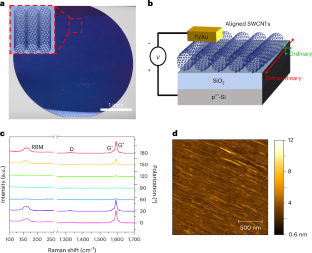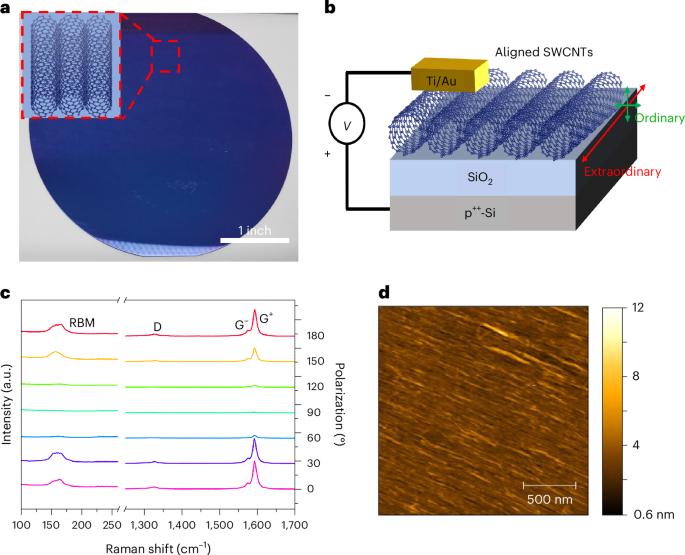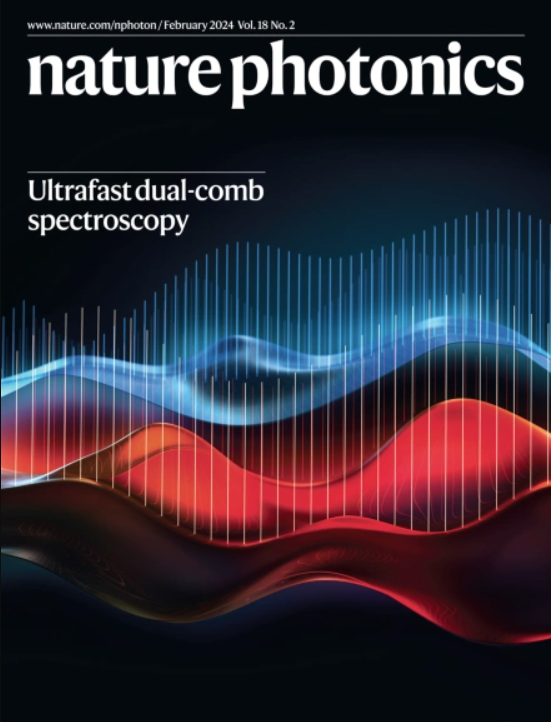Gate-tunable optical anisotropy in wafer-scale, aligned carbon nanotube films
IF 32.3
1区 物理与天体物理
Q1 OPTICS
引用次数: 0
Abstract
Telecommunications and polarimetry both require the active control of the polarization of light. Currently, this is done by combining intrinsically anisotropic materials with tunable isotropic materials into heterostructures using complicated fabrication techniques owing to the lack of scalable materials that possess both properties. Tunable birefringent and dichromic materials are scarce and rarely available in high-quality thin films over wafer scales. Here we report semiconducting, highly aligned, single-walled carbon nanotubes (SWCNTs) over 4″ wafers with normalized birefringence and dichroism values of 0.09 and 0.58, respectively. The real and imaginary parts of the refractive index of these SWCNT films are tuned by up to 5.9% and 14.3% in the infrared at 2,200 nm and 1,660 nm, respectively, using electrostatic doping. Our results suggest that aligned SWCNTs are among the most anisotropic and tunable optical materials known and open new avenues for their application in integrated photonics and telecommunications. Using electrostatic doping, the real and imaginary parts of the refractive index along the extraordinary axis of semiconducting, highly aligned, single-walled carbon nanotubes over 4″ wafers can be tuned by up to 5.9% and 14.3% in the infrared at 2,200 nm and 1,660 nm, respectively.


晶圆级排列碳纳米管薄膜中的栅极可调光学各向异性
电信和偏振测量都需要对光的偏振进行主动控制。目前,由于缺乏同时具备这两种特性的可扩展材料,实现这一目标的方法是通过复杂的制造技术,将固有各向异性材料与可调谐各向同性材料组合成异质结构。可调双折射材料和二色材料非常稀缺,很少有晶圆级的高质量薄膜。在此,我们报告了在 4 英寸晶圆上的半导体、高度排列的单壁碳纳米管(SWCNTs),其归一化双折射和二色性值分别为 0.09 和 0.58。通过静电掺杂,这些 SWCNT 薄膜的折射率实部和虚部在 2200 纳米和 1660 纳米波长的红外波段分别可调高 5.9% 和 14.3%。我们的研究结果表明,排列整齐的 SWCNT 是已知各向异性和可调谐性最强的光学材料之一,为它们在集成光子学和电信领域的应用开辟了新途径。
本文章由计算机程序翻译,如有差异,请以英文原文为准。
求助全文
约1分钟内获得全文
求助全文
来源期刊

Nature Photonics
物理-光学
CiteScore
54.20
自引率
1.70%
发文量
158
审稿时长
12 months
期刊介绍:
Nature Photonics is a monthly journal dedicated to the scientific study and application of light, known as Photonics. It publishes top-quality, peer-reviewed research across all areas of light generation, manipulation, and detection.
The journal encompasses research into the fundamental properties of light and its interactions with matter, as well as the latest developments in optoelectronic devices and emerging photonics applications. Topics covered include lasers, LEDs, imaging, detectors, optoelectronic devices, quantum optics, biophotonics, optical data storage, spectroscopy, fiber optics, solar energy, displays, terahertz technology, nonlinear optics, plasmonics, nanophotonics, and X-rays.
In addition to research papers and review articles summarizing scientific findings in optoelectronics, Nature Photonics also features News and Views pieces and research highlights. It uniquely includes articles on the business aspects of the industry, such as technology commercialization and market analysis, offering a comprehensive perspective on the field.
 求助内容:
求助内容: 应助结果提醒方式:
应助结果提醒方式:


